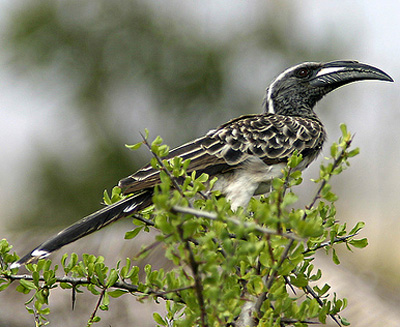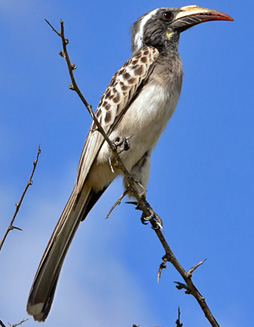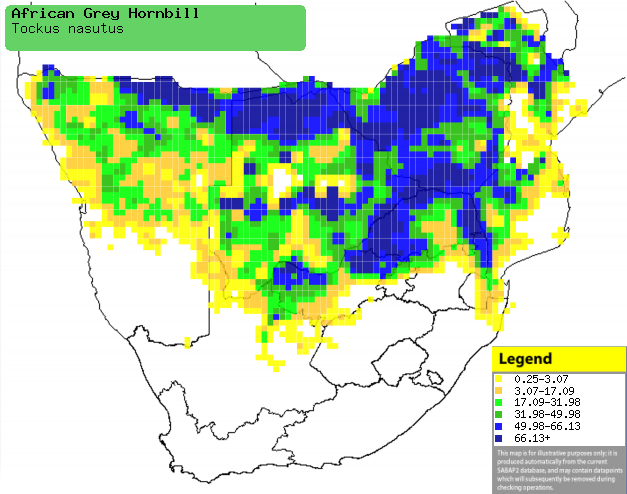|
Tockus nasutus (African grey
hornbill, Grey hornbill)
GrysneushoringvoŽl [Afrikaans]; Munkono [Kwangali];
Goto, Hoto (generic names for hornbill) [Shona]; Umkhotfo (generic term for
hornbill) [Swazi]; Nkorho (generic term for smaller hornbills) [Tsonga]; KŰrwÍ
[Tswana]; Grijze tok [Dutch]; Calao ŗ bec noir [French]; Grautoko [German];
Calau-cinzento [Portuguese]
Life
> Eukaryotes >
Opisthokonta
> Metazoa (animals) >
Bilateria >
Deuterostomia > Chordata >
Craniata > Vertebrata (vertebrates) > Gnathostomata (jawed
vertebrates) > Teleostomi (teleost fish) > Osteichthyes (bony fish) > Class:
Sarcopterygii (lobe-finned
fish) > Stegocephalia (terrestrial
vertebrates) > Tetrapoda
(four-legged vertebrates) > Reptiliomorpha > Amniota >
Reptilia (reptiles) >
Romeriida > Diapsida > Archosauromorpha > Archosauria >
Dinosauria
(dinosaurs) > Saurischia > Theropoda (bipedal predatory dinosaurs) >
Coelurosauria > Maniraptora > Aves
(birds) > Order: Bucerotiformes > Family: Bucerotidae
 |
 |
| African grey hornbil malel, Tanzania. [photo
Martin Goodey
©] |
African grey hornbill female, Kruger
National Park, South Africa. [photo Lorinda Steenkamp
©] |
The African grey hornbill occurs throughout the savannas of
sub-Saharan Africa. In southern Africa it is locally
common in a wide range of wooded savannas and woodland. It eats animals, such as
birds eggs and nestlings, insects, rodents and frogs, but it also occasionally
eats small fruit. It mainly nests in natural holes in tree trunks or branches,
the female sealing it with her own faeces. The female lays 3-5 eggs, which she
incubates for 24 days. The chicks stay in the nest for 43-49 days, joining their
parents in foraging trips a few weeks after fledging.
Distribution and habitat
Occurs throughout the savannas of sub-Saharan Africa. In
southern Africa it is locally
common in Zimbabwe, Botswana, northern Namibia, Mozambique, northern South
Africa and KwaZulu-Natal. It generally prefers wooded savannas and
woodland, ranging from miombo (Brachystegia) woodland to arid thornveld,
wooded gardens and alien tree plantations.
|
 |
|
Distribution of African grey hornbill in southern Africa,
based on statistical smoothing of the records from first SA Bird Atlas
Project (©
Animal Demography unit, University of
Cape Town; smoothing by Birgit Erni and Francesca Little). Colours range
from dark blue (most common) through to yellow (least common).
See here for the latest distribution
from the SABAP2. |
Call
Food
It mainly eats animals, such as
birds eggs and nestlings, insects, rodents and frogs, supplemented with small fruit. It mainly forages by flying to different bushes, catching
prey as it moves; it may also grab animals on the ground. The following
food items have been recorded in its diet:
- Animals
- Plants
- fruit
- Ficus (wild figs)
- Commiphora (corkwoods)
- peanuts
Breeding
- It usually nests in natural holes in tree trunks or
branches; once a site has been selected the female seals it from the inside
with her own faeces. Most of its nests have a "chimney" or "funk-hole",
which is a tunnel leading out from the cavity that the female moves into if
it feels threatened. It occasionally nests in rock crevices, barbet-made tree holes and nest boxes.
- Egg-laying season starts after first strong summer rains, peaking from
October-November.
- It lays 3-5 eggs at 1-7 day intervals, taking about 6-10 days to
complete the clutch.
- Incubation is done solely by the female for about 24 days, fed by
the male through the small entrance slit.
- The chicks stay in the nest for 43-49 days, although the female leaves
when the oldest chick is 19-34 days old, after which the chicks reseal the
entrance. After fledging the young join their parents on
foraging trips, becoming fully independent a few weeks later.
Threats
Not threatened, in fact its common in many areas,
especially in the Etosha National Park (Namibia), Hwange National Park (Zimbabwe) and the Kruger National Park (South Africa).
References
-
Hockey PAR, Dean WRJ and Ryan PG (eds) 2005. Roberts
- Birds of southern Africa, VIIth ed. The Trustees of the John Voelcker
Bird Book Fund, Cape Town.
|
